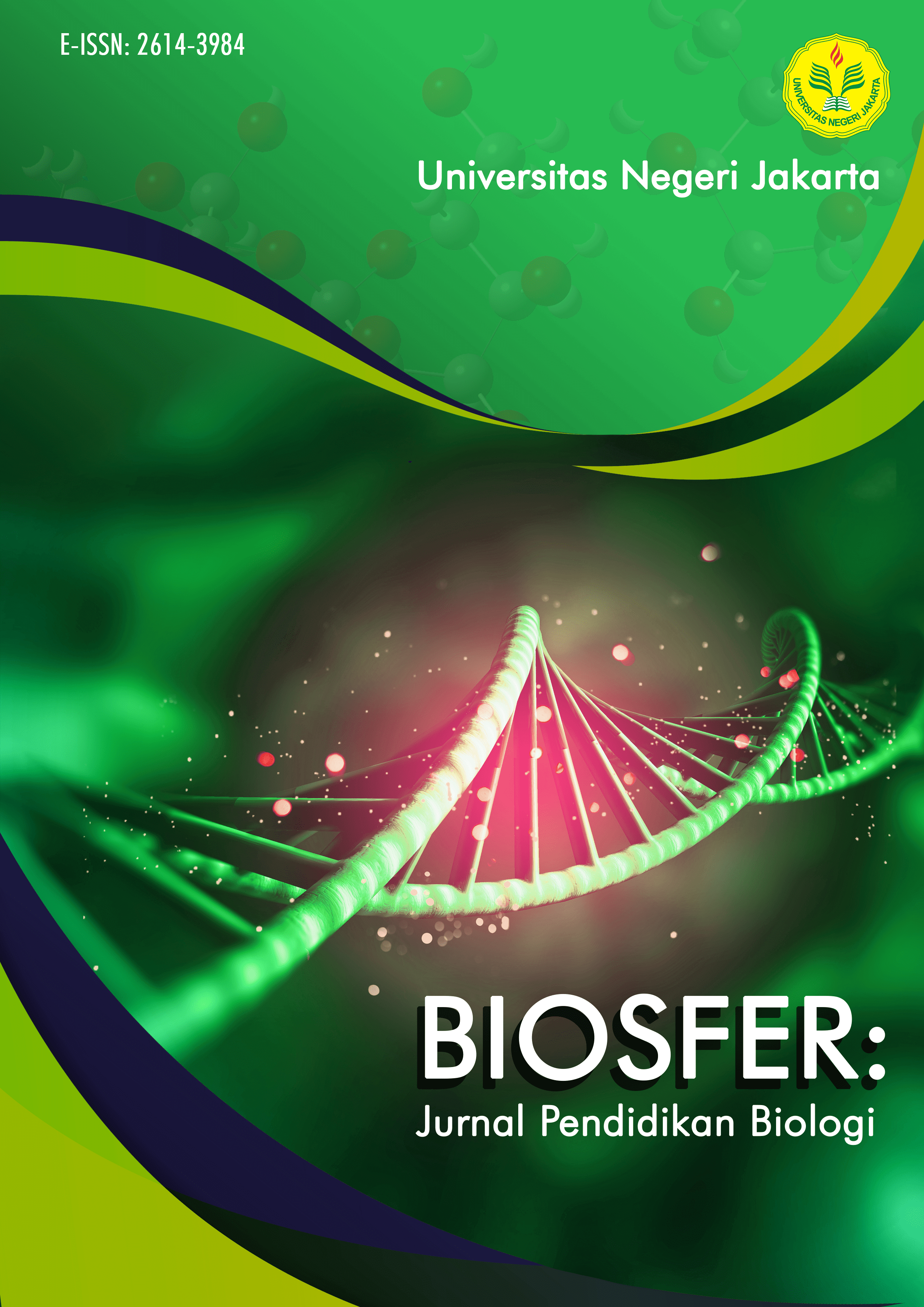Tradition and plants: Ethnobotany in the perlon unggahan ritual of the bonokeling lineage indigenous people
DOI:
https://doi.org/10.21009/biosferjpb.47561Keywords:
Bonokeling Lineage, Ethnobotany, Indigenous People of the Perlon , Unggahan RitualAbstract
The Bonokeling lineage, known in Indonesian as keturunan Bonokeling, is an indigenous community in Central Java, Indonesia, descended from Ki Bonokeling, a revered spiritual figure. They are known for preserving unique traditions and rituals that blend Javanese cultural values with Islamic teachings. One of their significant rituals is perlon unggahan, a ceremonial event held annually as a form of gratitude and preparation ahead of the fasting month of Ramadan. This study explores the tradition and the role of plants in the perlon unggahan ritual, focusing on their utilization and cultural significance. A qualitative research method with a phenomenological approach was employed, involving participatory observation, semi-structured in-depth interviews, documentation, and literature review. Data was collected from 11 informants selected through purposive sampling. The findings show that the ritual uses 39 plant species from 22 families. The Zingiberaceae family is the most frequently utilized. The most used plant parts are fruits, followed by leaves, stems, seeds, flowers, rhizomes, tubers, and sap. Among all the plants observed, krambil (Cocos nucifera L.) has the highest Species Use Value (SUV), which is highlighting its central role in the ritual. Plant use is categorized into three main functions: food, offerings, and ceremonial equipment. These findings underscore the importance of preserving both the cultural heritage and the biodiversity associated with this traditional ritual.
References
Arauf, M. A. (2023). The Existence of Women in the Traditional Rituals of the Jatilawang Bonokeling Community in Banyumas Regency. International Journal of Social Science and Religion (IJSSR), 347–366. https://doi.org/10.53639/ijssr.v4i3.187
Creswell, J. W. (2012). Educational Research: Planning, Conducting, and Evaluating Quantitative and Qualitative Research. Pearson.
Heidegger, M. (2005). Introduction to phenomenological research. Indiana university press.
Iskandar, J., Budiawati, & Iskandar. (2017). Various plants of traditional rituals: ethnobotanical research among the Baduy community. Biosaintifika: Journal of Biology & Biology Education, 9(1), 114–125. https://doi.org/10.15294/biosaintifika.v9i1.8117
Iskandar, J., Kusmoro, J., Mubarokah, M., & Partasasmita, R. (2018). Ethnobotany of banana plants (Musa x paradisiaca) of Palintang Hamlet, Cipanjalu Village, Bandung, West Java, Indonesia. Biodiversitas Journal of Biological Diversity. https://doi.org/10.13057/BIODIV/D190611
Jadid, N., Kurniawan, E., Himayani, C. E. S., Andriyani, Prasetyowati, I., Purwani, K. I., Muslihatin, W., Hidayati, D., & Tjahjaningrum, I. T. D. (2020). An ethnobotanical study of medicinal plants used by the Tengger tribe in Ngadisari village, Indonesia. Plos One, 15(7), e0235886. https://doi.org/10.1371/journal.pone.0235886
Kholifah, Tavita, G. E., & Indrayani, Y. (2020). Etnobotani ritual adat Suku Dayak di sekitar hutan di Desa Datah Dian Kabupaten Kapuas Hulu. Jurnal Hutan Lestari, 8(2), 379–395. https://dx.doi.org/10.26418/jhl.v8i2.40720
Mariati, Munir, A., & Samai, S. (2021). Etnobotani Tumbuhan Yang Digunakan Pada Ritual Pesta Adat Mosehe Wonua Suku Tolaki Mekongga Di Kabupaten Kolaka. AMPIBI: Jurnal Alumni Pendidikan Biologi, 6(3), 128–133. https://doi.org/10.36709/ampibi.v6i3.23339
Mukarromah, A. N., Dzihni, A., Azzam, A. K., Adiningsih, A. R., Utami, A. S., Nazar, I. A., Sunarto, S., Iskandar, J., Saensouk, S., & Setyawan, A. D. (2024). Ethnobotany of traditional rituals of Javanese in the city of Surakarta, Central Java, Indonesia. Asian Journal of Ethnobiology, 7(1). https://doi.org/10.13057/asianjethnobiol/y070103
Nurhazizah, N. (2021). Perbandingan Keanekaragaman Dan Pemanfaatan Family Zingiberaceae Dalam Kehidupan Suku Jawa Dan Suku Dayak. Jurnal Biologi Dan Pembelajarannya (JB&P), 8(2), 72–83. https://doi.org/10.29407/jbp.v8i2.16684
Pei, S., Alan, H., & Wang, Y. (2020). Vital roles for ethnobotany in conservation and sustainable development. Plant Diversity, 42(6), 399. https://doi.org/10.1016/j.pld.2020.12.001
Pertiwi, L., Harahap, R., Wuriyani, E. P., & Muhardinata, I. (2022). Kajian Makna Simbolik dalam Kembar Mayang pada Konteks Pernikahan Adat Jawa sebagai Pengayaan Bahan Ajar di Sekolah SD Negeri 106158. SAP (Susunan Artikel Pendidikan). https://doi.org/10.30998/sap.v7i1.12872
Purwanto, Y., Munawaroh, E., Ajiningrum, P. S., & Sujarwo, W. (2021). The Role of Ethnobiology in Responding to Current Problems in the Management of Biological Resources and Ecosystems in Indonesia. Advances in Social Sciences Research Journal, 8(8). https://doi.org/10.14738/assrj.88.10693
Ristiani, Fardani, M. A., & Riswari, L. A. (2024). Makna Sesaji Sedekah Bumi di Desa Triguno Kecamatan Pucakwangi. 11(1), 27–48. http://dx.doi.org/10.25157/ja.v11i1.13202
Safitri, Muhfahroyin, & Santoso, H. (2023). Studi Etnobotani Pada Proses Ritual Adat Masyarakat Bali Kecamatan Labuhan Maringgai Sebagai Sumber Belajar Biologi. Jurnal Biolova, 4(2), 121–128. https://doi.org/10.24127/biolova.v4i2.3570
Sari, I. A., Sulistijorini, & Purwanto, Y. (2020). Studi Etnoekologi Masyarakat Adat Trah Bonokeling Di Banyumas dan Cilacap. Jurnal Ilmu-Ilmu Hayati, 19(1), 59–69. https://doi.org/10.14203/beritabiologi.v19i1.3785
Saudah, S., Zumaidar, Z., Darusman, D., Roslim, D., & Ernilasari, E. (2022). Ethnobotanical knowledge of Etlingera elatior for medicinal and food uses among ethnic groups in Aceh Province, Indonesia. Biodiversitas Journal of Biological Diversity. https://doi.org/10.13057/biodiv/d230862
Sitanggang, N., Zuhud, E., Masy’ud, B., & Soekmadi, R. (2022). Ethnobotany of the Toba Batak Ethnic Community in Samosir District, North Sumatra, Indonesia. Biodiversitas Journal of Biological Diversity. https://doi.org/10.13057/biodiv/d231204
Sudiana, I. G. N. (2018). Caru dalam Upacara di Bali. IHDN Press.
Sulistiyowati, E., Setiadi, S., & Haryono, E. (2022). Food traditions and biodiversity conservation of the Javanese Community in Gunungkidul Karst, Yogyakarta Province, Indonesia. Biodiversitas Journal of Biological Diversity. https://doi.org/10.13057/biodiv/d230443
Syam, T. (2017). Symbolism Of Javanese Culture. 2nd International Conference on Social and Political Development (ICOSOP 2017), 447–451. https://doi.org/10.2991/ICOSOP-17.2018.69
Wahidah, B. F., Hayati, N., Khusna, U. N., Rahmani, T. P. D., Khasanah, R., Kamal, I., Husain, F., & Setiawan, A. I. (2021). The ethnobotany of Zingibraceae as the traditional medicine ingredients utilized by Colo Muria mountain villagers, Central Java. Journal of Physics: Conference Series, 1796(1), 12113. https://doi.org/10.1088/1742-6596/1796/1/012113
Zenderland, J., Hart, R., Bussmann, R. W., Paniagua Zambrana, N. Y., Sikharulidze, S., Kikvidze, Z., Kikodze, D., Tchelidze, D., Khutsishvili, M., & Batsatsashvili, K. (2019). The use of “use value”: quantifying importance in ethnobotany. Economic Botany, 73, 293–303. https://doi.org/10.1007/s12231-019-09480-1
Downloads
Published
How to Cite
Issue
Section
License
Copyright (c) 2025 Biosfer: Jurnal Pendidikan Biologi

This work is licensed under a Creative Commons Attribution 4.0 International License.
The Authors submitting a manuscript do so on the understanding that if accepted for publication, copyright of the article shall be assigned to Biosfer: Jurnal Pendidikan Biologi (Biosferjpb) and Departement of Biology Education, Universitas Negeri Jakarta as publisher of the journal.



